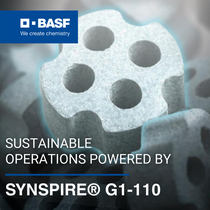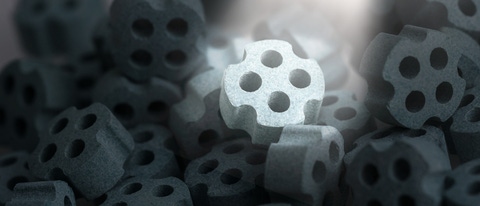SYNSPIRE®
Dry Reforming Catalysts: SYNSPIRE® G1-110
SYNSPIRE®: Dry reforming catalysts for advantageous plant operation - regarding coking, opex, capex and carbon footprint
Syngas generation based on the conventional steam reforming process requires considerable amounts of process steam. Producing this steam has a major impact on the plant's energy bill. This industry is therefore looking for ways to reduce the steam-to-carbon (S/C) ratio of syngas generation. With conventional reforming catalysts, the reduction of steam can ultimately lead to or accelerate deactivation of the catalyst due to carbon accumulation and coke formation.
The stabilized crystal structure and tuned catalyst composition of BASF's SYNSPIRE® G1-110 catalyst improves gasification activity and paves the way for coke-free operation under conditions with a low S/C ratio.
The benefits of SYNSPIRE®
With conventional reforming catalysts coking is initiated through deposition and insertion of a carbon species from the vapor phase into the metallic nickel (Ni) particles. Carbon accumulates at these weak points, forming carbon “whiskers“ and soft coke. This ultimately leads to deactivation of the catalyst.
- Unique structure and composition of metal oxide carrier
- No accumulation of C on catalyst surface
- No deactivation in dryer conditions

Designed to withstand coke formation
| SYNSPIRE® G1-110 | |
| Main active component | Ni-oxides |
| Shape and size | Green tablets, 4-hole quadrilobes, 15 mm x 8 mm |
| Tapped density | 0.9-1.1 kg/l |
| Packaging | 200 l steel drums |
| Expected lifetime | 5-8 years |
| Typical operating conditions | S/C < 1.8 [mol]/[mol] , H2/CO: 1-3 [mol]/[mol] |
| Typical operating temperature (outlet gas temp) | 800-950° C |
| Typical operating pressure | 20 – 40 bar |

Advantages for our customers
Linde‘s DRYREF™ syngas generation plant capitalizes on the features of this new catalyst based on a tailored set of steam reforming parameters.
More about Linde DRYREF™ and BASF SYNSPIRE®:
The synergized benefits of DRYREF™ & SYNSPIRE®
All about Linde's DRYREF™ process
Benefits at a glance
- New catalyst enabels coke-free operation
- Low OPEX – energy savings and lower costs
- CAPEX savings thanks to more compact equipment
- CO2 utilization as feedstock
- Smaller carbon footprint
Potential applications
- All processes with CO2 source that require a H2 /CO ratio < 3
- Various processes in the chemical industry
- Downstream process in oil and gas (refining)

Customer Success: NanYa Plastic Corp
With SYNSPIRE® G1-110, BASF's customer NanYa Plastic Corp unlocked new levels of efficiency at their 2‑Ethylhexanol plant: saving energy, reducing emissions, and advancing their sustainability goals. By materializing significant OPEX benefits, Nan Ya Plastic Corp’s site reduced CO₂ emissions by 38,000 metric tons per year.
